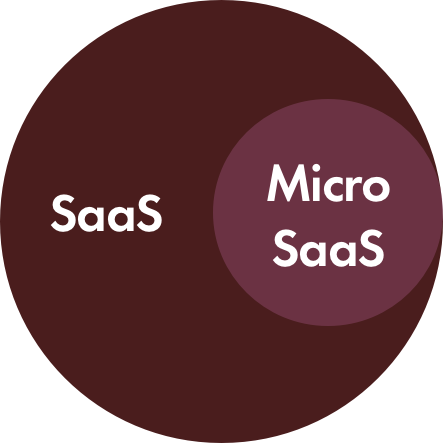How to Start a Micro-SaaS Company and Launch a Kickass Product?
Rishabh Pandey
The SaaS industry has seen exponential growth in recent years. The Micro-SaaS market is one of the most lucrative and fastest-growing segments of this industry. With so many entrepreneurs wanting to get started on their own, it can be hard to know where to start.
In this guide, we will cover all the steps you need to take from coming up with your idea for a product, launching that product, and marketing it successfully. We'll also answer some questions about what makes Micro-SaaS different than regular SaaS and how you can validate your ideas before investing too much time or money into them!
What is Micro-SaaS?
Micro-SaaS is a type of SaaS business where you solve one problem by offering a single solution. Instead of offering SaaS, which is an all-inclusive product that customers use for any number of tasks and projects, Micro-SaaS focuses on a single product or solution.
Micro-SaaS has seen exponential growth in recent years due to the fact that it's so much easier to focus on a single problem and to solve it for a specific customer avatar. It also comes with far less risks as you don't have to invest in all the infrastructure a SaaS product requires.
How Micro-SaaS is different from SaaS?
A SaaS company is usually an all-in-one service. A SaaS customer will typically use the software a business offers for any number of tasks and projects, whereas Micro-SaaS is fairly specific in what it can do.

What do you need to start a Micro-SaaS product?
To start a Micro-SaaS product, you need an idea for what type of problem or solution your business will offer.
You also need to find out if there is enough demand in the market for the service or product before moving forward with developing it any further. This can be done by talking to potential customers and asking them about their pain points.
Communication is the most important skill for any entrepreneur. You need to ensure that you're developing a product or service to address something your target customer actually needs.
Let's say you are building a CRM for realtors. The first thing you should do is talk to real estate agents and firms about their issues with their CRM and discover pain points.
After you have the idea, you'll need startup capital in order to execute your idea and launch it as well. This can be done by bootstrapping with personal funds or raising funding through investors or crowdfunding campaigns.
This list outlines the typical journey of an product from the idea to success.
Get ideas for your product
Validate your best idea by getting early feedback
Build your MVP (Minimum Viable Product) with your favorite tech stack
Launch to your niche and to popular websites
Grow organically
Monetize with recurring subscription plans
Automate parts of your business
Scale by hiring people or automating even more
Sell your product and start over
You don't have to follow the same path and your journey can be different from this. Let's get started and talk about startup ideas.

How to generate Micro-SaaS ideas?
Best startup ideas are organic. They come when an entrepreneur notices a problem they need to solve or simply. When they see an emerging trend that they want to capitalize on before others do.
These are some tips on how to get ideas for your startup:
- Keep looking at the problems around you and in your daily lives. Pay attention to what's becoming more frequent or is just "getting old". What will make people's life easier? Is there a trend that needs a solution, like artificial intelligence (AI) beating humans in games?
- Find content that you relate to on the internet and read more about it.
- Keep an idea journal by writing your ideas down as they come up or before going to sleep at night, even if it's just a couple of words or sentences. You'll be surprised how many good startup ideas can pop out of nowhere.
- Keep an open mind and remember that there can be a lot of different types of startup ideas - not just apps.
There are other ways to generate startup ideas as well, but these should not be your first choice. The ideas you generate non-organically can seem very promising at first but lead you to build a product where the idea sounds perfectly viable but is solving a problem no one actually has.
Here are a few easy ways you can get started.
- The first is to simply brainstorm and create a list of ideas. This could be anything from helping people find the perfect match on Tinder or making it easier for companies to hire new employees.
- Find a product similar to what you would love to build and look at its negative reviews. These reviews can help you find a problem with the product that your future customers want to resolve.
- Another great way to come up with saas ideas is by solving your own problems as an entrepreneur. If you're struggling with launching a new product or marketing it, then try coming up with the solution yourself and see if there are others in the same boat.
- Talk to other entrepreneurs and saas experts to see what they think are the biggest problems in saas.
- The final way to generate saas ideas is by looking at what's currently popular in society and thinking of how you could make it better. For example, if there are a lot of people complaining about the lack of customer service available nowadays, then focus on providing that type of saas solution.
How to validate Micro-SaaS ideas?
To validate SaaS ideas, you should first talk to potential customers and see if they want a product which you want to build.
Polling your audience is one way of doing this without investing too much time or money in the idea. You could reach out to them about their problems with an existing SaaS product that's similar to what you're planning on building.
It's important not to get too attached or invested in one idea before you've validated it because it could take a while before you see any return on your time and efforts and most of the time startups have to pivot.
Find products which are trying to solve a similar problem and see how well they're doing. Talking to potential customers about their experience with an existing saas product.
A startup called Dropoff talked to people about the difficulties they experienced when picking up and dropping off their kids at school. They found that parents would often worry about whether there would be any parking available, which is why Dropoff is now providing valet parking at various schools in New York City.
Platforms like Reddit are easy to use and have some of the largest communities on the internet. You can find a subreddit that matches your saas idea and talk to people about their problems with similar saas products.
- Social media is another great place to validate saas ideas by reaching out to people and asking them if they'll be interested in your saas product.
Try to find people with an interest in what you want to build and get them involved in your startup journey. These are the same people who will talk about your product and help you gain traction.
How to build a Micro-SaaS product?
Now that you've come up with your SaaS idea and have validated it, the next step is coming up with how exactly you want customers to access your SaaS service. There are two common ways this can be done:
- The first option would be building an app for your SaaS product, which makes it available across all platforms.
- The second option would be to build a website for your SaaS business that people can access through their web browser and is usually best if you have budget constraints.
No matter what type of SaaS solution you want to offer, some programming knowledge is required to do build a SaaS product. If you are a non-technical founder we strongly recommend you to partner with an agency like us to help with the technical aspects of this process.
You can contact us by [booking a discovery call](https://calendly.com/buffermint/30min) to discuss your idea.
How to launch a Micro-SaaS product?
The first step to launching SaaS products is figuring out the right time of year for you to release your SaaS solution, as this can depend on what type of product or service you're providing and how much money you have available at the start-up stage.
Launching SaaS products can be an extremely exciting time for any entrepreneur. However, it's important not to get your hopes up too much with the first version of your product. You should also make sure to develop a product roadmap and an effective marketing plan in order to gain traction.
How to market a Micro-SaaS product?
Marketing SaaS products can be one of the most challenging tasks for any SaaS entrepreneur. However, it's important not to put all your eggs in one basket and focus on developing different types of marketing campaigns. Below are five saas marketing channels that saas companies should be leveraging in today's digital landscape.
- Email marketing: this is a good marketing channel for saas companies because they offer the ability to personalize each message and deliver it in specific ways.
- SEO (search engine optimization): this marketing channel is especially important, as it allows businesses to rank higher on Google search results pages and generate more leads for their business. It's recommended that marketers focus on high-quality content and spend time building links to their website for SaaS products.
- Social Media Marketing: this is an important strategy because it allows companies to reach out and connect with customers in the digital world by focusing on Facebook, Twitter, Instagram or LinkedIn posts that can help promote their business. It's also recommended for businesses to create content to grow their social media following.
- PPC (pay per click) marketing: this is another important strategy because it allows SaaS companies to reach out and generate sales by paying a variable cost each time somebody clicks on the advertisement. This type of advertising can be especially effective for companies who have a good conversion rates on their landing page.
How to get first user feedback?
The SaaS idea you've come up with is great, but how do you know if customers are going to like it once they start using the product or service? It's hard for any entrepreneur not to want validation when launching their SaaS business. The best way to figure out what your SaaS customers think of your SaaS product is to ask them for feedback.
The best way to get feedback from SaaS users is by using a simple one-question survey that you can email out or create on Google Forms, and then follow up with those who answer the question in order to gauge their interest levels. You could also reach out to SaaS users and ask them for feedback on your SaaS solution through social media platforms like LinkedIn.

Make It Happen
Find a problem to solve.
Build a product that solves this problem.
Determine the best way to reach your audience and get feedback on your SaaS idea - either through an app or website.
Develop the saas product and launch it into the market.
Collect feedback from customers, validate saas idea, iterate as needed, repeat steps 1-4 until you have found success in launching saas products.
The saas market is growing and the right opportunity to take advantage of it is right now. The saas market was projected to reach \$284 billion by 2025. That means entrepreneurs like you have the potential to generate a lot of revenue in a short time span.
If you're looking for a more in-depth guide that covers the strategies we use to build and launch SaaS products, check out more of our posts.
Get our articles delivered
From us to your inbox weekly.
Suggested Articles
Here are a few more articles you might like.





